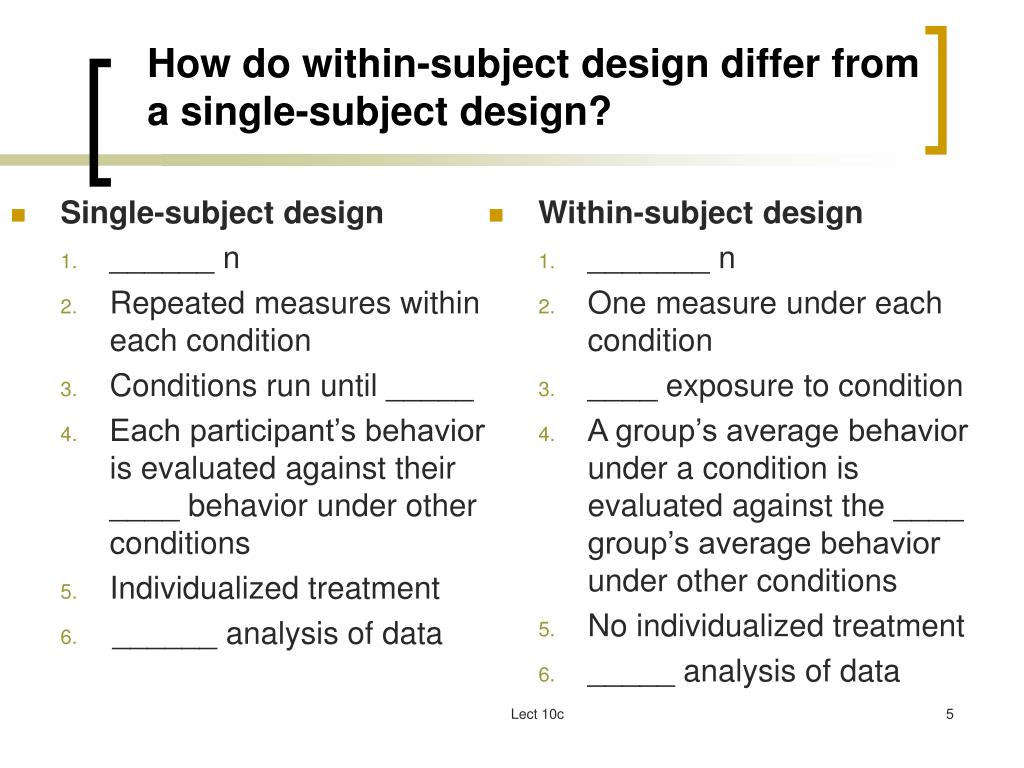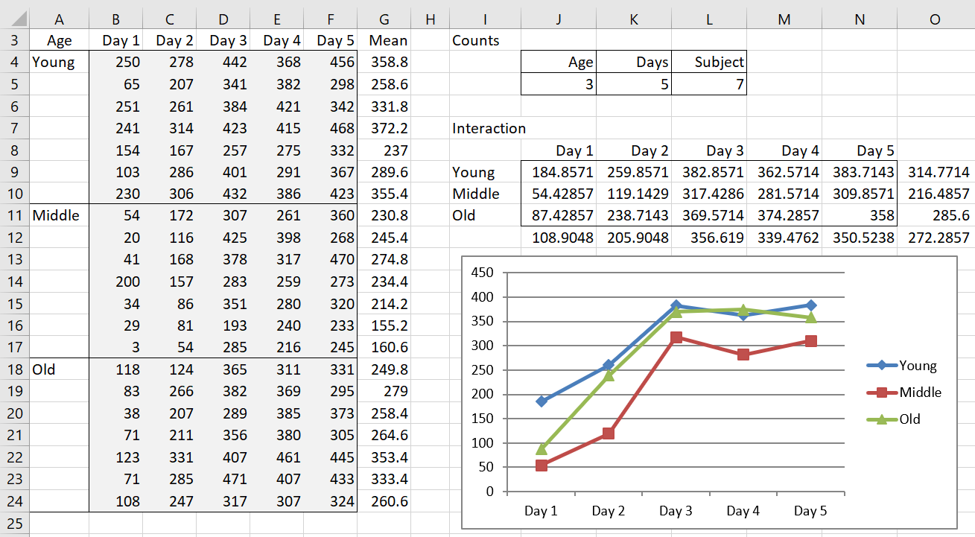7 5: Between Subject Designs
Table Of Content

These types of erroneous conclusions can be practically significant with important consequences, because they lead to misplaced investments or missed opportunities. Data cleaning involves spotting and resolving potential data inconsistencies or errors to improve your data quality. An error is any value (e.g., recorded weight) that doesn’t reflect the true value (e.g., actual weight) of something that’s being measured. Both receiving feedback and providing it are thought to enhance the learning process, helping students think critically and collaboratively.
Examples of Between Subjects Design
Perhaps the most important advantage of within-subject designs is that they make it less likely that a real difference that exists between your conditions will stay undetected or be covered by random noise. By comparing the average blood pressure of the two groups, the effect of the medication on blood pressure can be assessed, but researchers cannot directly compare the blood pressure of individual participants. This key characteristic would be the independent variable, with varying levels of the characteristic differentiating the groups from each other. A within-subjects design should not be used if researchers are concerned about the potential interferences of practice effects. The primary goal of a within-subjects design is to determine if one treatment condition is more effective than another. In mixed methods research, you use both qualitative and quantitative data collection and analysis methods to answer your research question.
Simultaneous Within-Subjects Designs

But if the study is between-subjects, the happy participant will only interact with one site and may affect the final results. You’ll have to make sure you get a similar happy participant in the other group to counteract her effects. Ideally, your participants should be randomly assigned to one of the groups to ensure that the baseline participant characteristics are comparable across the groups. Alternatively, you can have numerous groups with a key differentiating variable, like ethnicity, sexuality, or gender identity. You typically would use a within-subjects design when you want to investigate a causal or correlational relationship between variables with a relatively small sample. Since the same individuals participate in all conditions, there will be no effects from variations in individual differences between conditions.
Order Effects and Counterbalancing
They can provide useful insights into a population’s characteristics and identify correlations for further research. To use a Likert scale in a survey, you present participants with Likert-type questions or statements, and a continuum of items, usually with five or seven possible responses, to capture their degree of agreement. The downsides of naturalistic observation include its lack of scientific control, ethical considerations, and potential for bias from observers and subjects. Researchers’ own beliefs and expectations about the study results may unintentionally influence participants through demand characteristics.
Frequently Asked Questions
It’s a relatively intuitive, quick, and easy way to start checking whether a new measure seems useful at first glance. In research, you might have come across something called the hypothetico-deductive method. It’s the scientific method of testing hypotheses to check whether your predictions are substantiated by real-world data.
When a test has strong face validity, anyone would agree that the test’s questions appear to measure what they are intended to measure. Although both types of validity are established by calculating the association or correlation between a test score and another variable, they represent distinct validation methods. Convergent validity shows how much a measure of one construct aligns with other measures of the same or related constructs. Many people are not surprised that placebos can have a positive effect on disorders that seem fundamentally psychological, including depression, anxiety, and insomnia.
What is within-subjects study design?
This article delves deeper into the nuances and applications of a between-subjects design. In randomisation, you randomly assign the treatment (or independent variable) in your study to a sufficiently large number of subjects, which allows you to control for all potential confounding variables. The primary advantage of this approach is that it provides maximum control of extraneous participant variables. Participants in all conditions have the same mean IQ, same socioeconomic status, same number of siblings, and so on—because they are the very same people.
Shoulder and elbow joint position sense assessment using a mobile app in subjects with and without shoulder pain ... - ScienceDirect.com
Shoulder and elbow joint position sense assessment using a mobile app in subjects with and without shoulder pain ....
Posted: Sat, 30 Mar 2019 19:18:55 GMT [source]
Between-Subjects Experiments
All questions are standardised so that all respondents receive the same questions with identical wording. Naturalistic observation is a qualitative research method where you record the behaviours of your research subjects in real-world settings. In this process, you review, analyse, detect, modify, or remove ‘dirty’ data to make your dataset ‘clean’. After data collection, you can use data standardisation and data transformation to clean your data. You can use exploratory research if you have a general idea or a specific question that you want to study but there is no preexisting knowledge or paradigm with which to study it.
Between Subjects Design
The different design options will be a manipulation of your independent variable. The time it takes users to complete the task could change based on these modifications, making task completion your dependent variable. This type of experiment could help you gain insight into which website design is most intuitive for users to use. In a mixed factorial design, researchers will manipulate one independent variable between subjects and another within subjects.
You can keep data confidential by using aggregate information in your research report, so that you only refer to groups of participants rather than individuals. Here, the researcher recruits one or more initial participants, who then recruit the next ones. If the test fails to include parts of the construct, or irrelevant parts are included, the validity of the instrument is threatened, which brings your results into question.
Then, you would administer the same test to all participants and compare test scores between the groups. Saul Mcleod, PhD., is a qualified psychology teacher with over 18 years of experience in further and higher education. He has been published in peer-reviewed journals, including the Journal of Clinical Psychology. This means that your editor will understand your text well enough to give feedback on its clarity, logic and structure, but not on the accuracy or originality of its content. However, our editors are language specialists, not academic experts in your field. Your editor’s job is not to comment on the content of your dissertation, but to improve your language and help you express your ideas as clearly and fluently as possible.

Your study wants to determine if a new Logo will increase positive reviews on a company’s website. The company Logo will be the independent variable, while the positive reviews will be the dependent variable. A within-subjects design is more statistically powerful than a between-subjects design, because individual variation is removed. To achieve the same level of power, a between-subjects design often requires double the number of participants (or more) that a within-subjects design does. Counterbalancing is sometimes more convenient for researchers because an even portion of the sample undergoes each sequence of conditions selected by researchers.
Data validation at the time of data entry or collection helps you minimize the amount of data cleaning you’ll need to do. When your population is large in size, geographically dispersed, or difficult to contact, it’s necessary to use a sampling method. The higher the content validity, the more accurate the measurement of the construct.
In a between-subjects design, each participant is only given one treatment, so every session can be fairly quick. A between-subjects design would require a large participant pool in order to reach a similar level of statistical significance as a within-subjects design. Randomisation and counterbalancing of the order of conditions can help reduce carryover effects. Carryover effects are a broad category of internal validity threats that occur when an earlier treatment alters the outcomes of a later treatment. To randomise treatment order, the order of the short stories is completely randomised between participants using a computer program.
Comments
Post a Comment